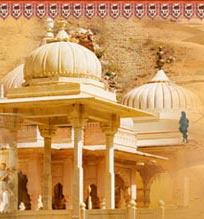 |
Rajasthan is a land of rich cultural heritage. Read about the folk and miniature paintings of Rajasthan.
|
Rajasthan Paintings
Rajasthan has been a great center of Indian arts and crafts in general and paintings in particular. The decoration of dwellings and other household objects was but one aspect of the creative genius of the Rajasthani - the world of miniature paintings is perhaps the most fascinating and the distinctive styles that have existed here are renowned the world over. From the 16th century onwards there flourished different schools of paintings like the Mewar School, the Bundi-Kota kalam, the Jaipur, Bikaner, Kishengarh and Marwar schools.
Influenced by the surroundings, these medieval paintings have their own unique styles - the hills and valleys, deserts, places and forts, gardens, court scenes, religious processions and those highlighting scenes from the life of Lord Krishna were the recurrent themes of these paintings. The Raagamala paintings and those based on Goeta Govinda are treasures of Rajasthan. It is widely believed that the miniature artists of Rajasthan were practicing and perfecting their art as early as the beginning of the 16th century and were later employed by the Mughal courts, especially by the Great Mughal emperor Akbar.
Each school of painting had its distinctive features. For instance, the flowing rivers, dense forests, lush green fields of Kota-Bundi region were transferred to the paintings of those regions. In palaces of Kota-Bundi are displayed the paintings depicting hunting scenes and animal fights. Other than Nature, the figures of women are graceful, with well proportioned bodies and sharp features. Colors used are mainly bright, with red prominently appearing n the background. Areas in the vicinity of this region, like Uniara, Indergarh and Sarola were also influenced by the Kota and Bundi kalam.
Miniature Paintings, Kota
The ruler of Amer-jaipur were closest to the Mughals and had maintained political and social links with them therefore, it was only natural to find a strong Mughal influence in the paintings here. Examples of this can be understood in the paintings in the palaces of Amer, Bairat and Toda Rai Singh and much later in Samod, Achrol, Shahpura, Alwar and Tonk.The Kishengarh School is best known for its Bani Thani paintings. A totally different style with highly exaggerate features - long necks, large, almond shaped eyes, long fingers and the use of subdued colors. The originality of style can be credited to its royal patron - Raja Sawant Singh, better known as Nagari Das. The usual court scenes have also been painted h-ere but it was Nagari Das and his love for the singer-poet Bani Thani which gave this tiny state the most refined and delicate paintings.
Jodhpur has a very strong folk tradition and here the figures are mainly robust warriors and dainty women. Paintings of the legendary lovers like Dhola-Maru on camelback, hunting scenes which included innumerable horses and elephants dominate the paintings of the Marwar region. Similarly, Bikaner too had strong Mughal influences and developed a style which was a combination of both the local as well as borrowed styles. The colors used by the miniature artists were made from minerals, vegetables, precious stones, indigo, conch shells, pure gold and silver. The prepariing and mixing of colors was an elaborate process and it took weeks, sometimes months, to get the desired results. Very fine, specially created brushes were made for different kinds of paintings. The landscape changed, the colours used were varied, paintings were done on paper and palm leaf to illustrate manuscripts, and on walls of palaces and the inner chambers of forts, Havelis (the painted Havelis of Shekhawati are well-known), and paintings were done on cloth. But the importance of miniatures has never diminished -even after all these years. Pure Rajput paintings and those influenced by the Mughal court provide an interesting insight into the lifestyle of the centuries and continue to fascinate scholars to this day. Artists in Jaipur, Nathdwara and Kishengarh still work on miniatures and some of them produce excellent work. There have been several new developments but on the whole, the magical quality of the miniature continuous to live on.
In a different class but with several similarities are the cloth paintings of Rajasthan which include the phads - scroll paintings used by the Bhopas and the pichwais - cloth hangings used behind the deity in Vaishnava temples. Done in bright colors with bold outlines, these paintings have very strong religious traditions. And the artist who works on them considers himself to be a servant of the Lord and puts in shraddha or devotion on each pichwai or phad that he paints.
Influenced by the surroundings, these medieval paintings have their own unique styles - the hills and valleys, deserts, places and forts, gardens, court scenes, religious processions and those highlighting scenes from the life of Lord Krishna were the recurrent themes of these paintings. The Raagamala paintings and those based on Goeta Govinda are treasures of Rajasthan. It is widely believed that the miniature artists of Rajasthan were practicing and perfecting their art as early as the beginning of the 16th century and were later employed by the Mughal courts, especially by the Great Mughal emperor Akbar.
Each school of painting had its distinctive features. For instance, the flowing rivers, dense forests, lush green fields of Kota-Bundi region were transferred to the paintings of those regions. In palaces of Kota-Bundi are displayed the paintings depicting hunting scenes and animal fights. Other than Nature, the figures of women are graceful, with well proportioned bodies and sharp features. Colors used are mainly bright, with red prominently appearing n the background. Areas in the vicinity of this region, like Uniara, Indergarh and Sarola were also influenced by the Kota and Bundi kalam.
Miniature Paintings, Kota
The ruler of Amer-jaipur were closest to the Mughals and had maintained political and social links with them therefore, it was only natural to find a strong Mughal influence in the paintings here. Examples of this can be understood in the paintings in the palaces of Amer, Bairat and Toda Rai Singh and much later in Samod, Achrol, Shahpura, Alwar and Tonk.The Kishengarh School is best known for its Bani Thani paintings. A totally different style with highly exaggerate features - long necks, large, almond shaped eyes, long fingers and the use of subdued colors. The originality of style can be credited to its royal patron - Raja Sawant Singh, better known as Nagari Das. The usual court scenes have also been painted h-ere but it was Nagari Das and his love for the singer-poet Bani Thani which gave this tiny state the most refined and delicate paintings.
Jodhpur has a very strong folk tradition and here the figures are mainly robust warriors and dainty women. Paintings of the legendary lovers like Dhola-Maru on camelback, hunting scenes which included innumerable horses and elephants dominate the paintings of the Marwar region. Similarly, Bikaner too had strong Mughal influences and developed a style which was a combination of both the local as well as borrowed styles. The colors used by the miniature artists were made from minerals, vegetables, precious stones, indigo, conch shells, pure gold and silver. The prepariing and mixing of colors was an elaborate process and it took weeks, sometimes months, to get the desired results. Very fine, specially created brushes were made for different kinds of paintings. The landscape changed, the colours used were varied, paintings were done on paper and palm leaf to illustrate manuscripts, and on walls of palaces and the inner chambers of forts, Havelis (the painted Havelis of Shekhawati are well-known), and paintings were done on cloth. But the importance of miniatures has never diminished -even after all these years. Pure Rajput paintings and those influenced by the Mughal court provide an interesting insight into the lifestyle of the centuries and continue to fascinate scholars to this day. Artists in Jaipur, Nathdwara and Kishengarh still work on miniatures and some of them produce excellent work. There have been several new developments but on the whole, the magical quality of the miniature continuous to live on.
In a different class but with several similarities are the cloth paintings of Rajasthan which include the phads - scroll paintings used by the Bhopas and the pichwais - cloth hangings used behind the deity in Vaishnava temples. Done in bright colors with bold outlines, these paintings have very strong religious traditions. And the artist who works on them considers himself to be a servant of the Lord and puts in shraddha or devotion on each pichwai or phad that he paints.






